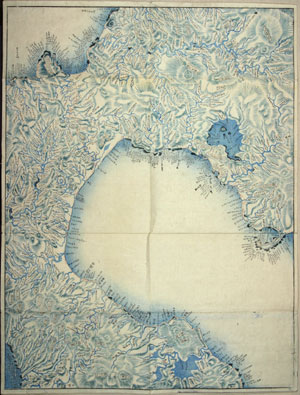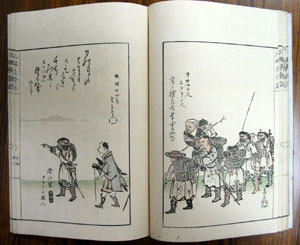本文
英語版
Matsuura Takeshiro
The footprints of Matsuura Takeshiro are guide towards the future
Left by those who realised his dream
In those tracks, there are many messages,teaching us the importance of believing in tommorow.
Matsuo Basho, Motoori Norinaga and Matsuura Takeshiro are the great figures born of Mie prefecture.
Matsuura was the first to explore Hokkaido and many of the remotest areas of the country.
His investigations were so extensive, it is said that if one were to connect the routes of his treks, you would have a complete map of Japan.
Among his travels, his 6 expeditions to Ezochi, now known as Hokkaido, resulted in numerous publications documenting his findings which are still regarded as valuable resources even today. From this, his work as a development official for the Meiji government and his responsibility for the enacting of many place names in the northern island, he came to referred to as“The Godparent of Hokkaido”.
Matsusaka City remembers his great achievements in the Matsuura Takeshiro Memorial Museum, where many preserved articles of his life and travels are displayed.
Here, the history of his accomplishments passed on, not only to the local people, but to the many visitors to the city.
Matsuura Takeshiro Memorial Museum
In the Matsuura Takeshiro Memorial Museum, numerous valuable materials donated to Matsusaka city (Old Mikumo town) by the Matsuura family are on display.
Almost all were designated as a national important cultural asset in 2008. Whereas before access was limited to those visiting Takeshiro's birthplace for academic study, now these treasures can be seen by all
Matsusaka's “Godparent of Hokkaido”The Life of Matsuura Takeshiro
About 190 years ago in 1818, Takeshiro was born in Sugawa village (present day Onoe town, Matsusaka City),the fourth son of the Matsuura household.
This name, given by his father drawing on a connection to the year of the tiger in which his son was born, means “bold fourth son”.
At the age of 7, Takeshiro began to learn calligraphy from the priest of Shinkakuji temple, Raioh Osho, and later sinography under Hiramatsu Rakusai of the Tsu fiefdom from the age of 12. Influenced by the elite scholars visiting the Hiramatsu school, he realised the need to travel and observe to deepen his studies. Upon eventually leaving the school at the age of 16, he embarked on his first trip.
Before long, the 17 year old Takeshiro set off an extensive pilgrimage.
In those days, it was said that one could travel 40 kilometres per day with difficulty, yet the slightly built Takeshiro usually managed as many as 60.
After climbing the main mountains and working in service at one of the great residences in Edo (Tokyo), he became a monk of a Zen temple in Nagasaki, taking the name Bunkei. When he was 26, returned home after an absence of 10 years, only to find that his parents had passed away while he was gone.
While in Nagasaki, Takeshiro had heard of the approach of Russian ships to the northern most tip of Japan. This was to be a major turning point of his life.
In 1843, driven by patriotism, he firmly resolved to travel to Ezochi, now known as Hokkaido, to see it with his own eyes as soon as possible. This resolution was to be fulfilled 2 years later.
At last, at 28, he was on a ship bound for Ezochi, but in those times, crossing the Tsugaru Straits was not a simple matter. To protect themselves against the rough seas, sailors had to wear coats made of seaweed and tie themselves together at the waist. And when the storms came, as the waves rushed against the ship, it was all they could do to pray to the gods to save them. Ezochi was a land to be reached only at great risk to life and limb.
On this first expedition to the island, Takeshiro made it far as Cape Shiretoko Misaki, where he left a marker bearing the inscription “Ise province, ichishi county, south of Kumozugawa river - Matsuura Takeshiro”, before returning to Hakodate. And it was as he passed along on this first trip that he came to know of the existence of the native people of Ezochi, the Ainu.
Returning for the second time in 1846, he gradually built up a friendship with the Ainu guides he was working with. From then on, besides continuing his explorations of Ezochi, he actively studied their language. It was on his third Ezochi expedition that he realised the plight of the Ainu, who were being worked to death by the Matsumae fiefdom and their contractors, who held authority over the territory.
Before long, he returned home and put together “A Journal of Ezochi Voyage”, the records of his travels so far. These records were used by others not only as a guidebook to, but also as an example of how to conduct investigative field surveys of Ezochi. Eventually, due to these logs and the lobbying of Takeshiro, Ezochi came under the control of the shogunate government. This of course earned him the wrath of the Matsumae fiefdom.
In 1855, the 37 year old travel-loving Takeshiro had not been on the road for 5 years. During that period, major events such as the arrival of Commodore Perry’s “Black Ships” and the death of General Ieyoshi had shaken Japan. For the second time, Takeshiro’s life reached a major turning point. With the establishment of the Hakodate Magistrates Office, he was able to go again to his beloved Ezochi, this time as a government official.
Arranging the construction of a road through to the west of Ezochi was his job. He returned to Ezochi three more times in the 4 year period until 1859 that he worked for the shogunate. His achievements from these days can be gathered from the subsequent voluminous publications. Among these, in “Modern People of Ezochi” he expressed his belief that the Ainu should be regarded as human beings, rather than as primitives, a first step towards completely transforming the opinion government officials of the time held of the Ainu. In others, he documented all sorts of flora and fauna, crafts, legends and customs native to the land and the people of Ezochi. Takeshiro was certainly among the most prominent writers and publishers of the closing days of the shogunate.
Based on his numerous achievements and his unrivaled knowledge of the region, the early Meiji government appointed Takeshiro Ezochi Development Commissioner in 1869. Right away, he proposed renaming Ezochi Hokkaido, and furthermore, the use of Ainu names for various regions and counties. This is the reason Takeshiro is known as “The Godparent of Hokkaido”.
Upon resigning his government post in 1874, Takeshiro travelled for a period. His closing years were devoted to the climbing mountain of Ohdaigahara, on the border of Mie and Nara Prefectures near his birthplace, an area that struck him like as much like Hokkaido.
He loved Ohdaigahara so much, he decided upon it as the place he would pass away. But, in 1888, before he could return there as planned, Takeshiro died from a stroke in Home in Kandagokenchou in Tokyo. According to his wishes a gravestone was erected in Nagoya valley, Ohdaigahara, the following year, remaining as a memorial to Takeshiro to this day.

Ezochi (Hokkaido) Map
A map of Hokkaidou and Minami Chishima island made up of 26 longitudinal sections. It shows details even to the far inland regions, including Ainu placenames.

Karafuto (Southern Region)
A map of southern Karafuto (corresponding to the former extent of Japanese territory), handdrawn by Takeshiro. Drawn in the same style as the Ezochi Map, originally in separate longitudinal sections, it was later renovated into this large hanging scroll.

Ezo Manga
A pictorial record of Ainu customs published by Takeshiro in 1859.

Outline Map of Ezochi Provincial Divisions
A map of Ezochi, including Karafuto and Chishima islands published in 1860. A reduction of more detailed north and east/west area maps.

North Ezo Expedition Report
An account of a Karafuto expedition. This area was explored with Karafuto Ainu guides.

The Published Works of Takeshiro
“Ishikari Diary”, “Kusuri Diary”, “Tokachi Diary” and others that are accounts of various geographical surveys, and the “West Ezo Diary” and “East Ezo Diary” with their travel notes, maps and guides, are just a few of Takeshiro’s many works.

Portable Brush and Ink Case
Portable ink and writing Brush, thought to have been used by Takeshiro.

Hokkaido Name Selection Submission
Takeshiro submitted 6 options as new names. One was adopted by the government, then changed slightly to Hokkaido, the name by which Ezochi is known today.

Hokkaido County Map
A Complete map of the Hokkaido counties, including Karafuto and Chishima islands, published by Takeshiro in 1869 through the Hokkaido Development Office. A southern oriented map.
このページに関するお問合せ
松阪市 教育委員会 文化課
〒515-8515 松阪市殿町1315番地3
電話:0598-53-4397






